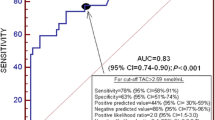Abstract
Brain trauma is an important cause of mortality and disability among young people worldwide. One of the mechanisms of post-traumatic secondary brain damage is related to free radical release and oxidative stress (OS). OS is the consequence of an imbalance between pro-oxidants and antioxidants in favor of pro-oxidants. This imbalance may lead to macromolecule damage including lipid peroxidation, protein crosslinking, DNA damage and changes in growth and function of cells in brain. Free radical release and subsequent lipid peroxidation are early events following neural tissues injury and are associated with hypo-perfusion, edema, and disruption of axonal guidance. In this study, we determined the prooxidant–antioxidant balance (PAB) in patients with brain injury, and its correlation with number of demographic and clinical parameters. Sera from 98 patients with traumatic brain and 100 healthy subjects were collected. The serum PAB was measured. Age, sex, GCS (Glasgow coma scale), mechanism of injury, brain lesions found on CT scan and lesions in other parts of the body, caused by trauma, were determined. A significantly higher PAB value was observed in the patient group (138.97 ± 15.9 HK unit) compared to the controls (60.82 ± 12.6 HK) (P = 0.001). In the patient group, there was no significant correlation of PAB with GCS, brain lesion characteristic, mechanism of injury, other accompanying traumatic injury, age and gender. When patients were classified into three groups according to GCS: group 1 (GCS>13, n = 28, PAB serum value = 138.51 ± 62.66 HK), group 2 (GCS between 8 and 12, n = 29, PAB serum value = 162.7 ± 50.6 HK) and group 3 (GCS <8, n = 41, PAB serum value = 155.56 ± 58.21 HK); there was no significant difference between groups. The serum PAB values were higher in patients with traumatic brain injury, although this was not associated with the extent of injury.

Similar content being viewed by others
Abbreviations
- TOS:
-
Total oxidant status
- FOX:
-
Ferrous ion oxidation xylenol orange
- GCS:
-
Glasgow coma scale
- PAB:
-
Prooxidant–antioxidant balance
- TBI:
-
Traumatic brain injury
- ROS:
-
Reactive oxygen species
References
Freire MA (2012) Pathophysiology of neurodegeneration following traumatic brain injury. West Indian Med J 61:751–755
Halliwell B (2006) Oxidative stress and neurodegeneration: where are we now? J Neurochem 97:1634–1658
Alamdari DH, Paletas K, Pegiou T, Sarigianni M, Befani C, Koliakos G (2007) A novel assay for the evaluation of the pro-oxidant–antioxidant balance, before and after antioxidant vitamin administration in type II diabetes patients. Clin Biochem 40:248–254
Delanty N, Dichter MA (1998) Oxidative injury in the nervous system. Acta Neurol Scand 98:145–153
Hussain SP, Hofseth LJ, Harris CC (2003) Radical causes of cancer. Nat Rev Cancer 3:276–285
Erel OA (2005) New automated colorimetric method for measuring total oxidant status. Clin Biochem 38:1103–11011
Erel O (2004) A novel automated method to measure total antioxidant response against potent free radical reactions. Clin Biochem 37:112–119
Alamdari DH, Ghayour-Mobarhan M, Tavallaie S, Parizadeh MR, Moohebati M, Ghafoori F et al (2007) Prooxidant–antioxidant balance as a new risk factor in patients with angiographically defined coronary artery disease. Clin Biochem 41:375–380
Werner C, Engelhard K (2007) Pathophysiology of traumatic brain injury. Br J Anaesth 99:4–9
Hall ED, Vaishnav RA, Mustafa AG (2010) Antioxidant therapies for traumatic brain injury. Neurotherapeutics 7:51–61
Ramana KV (2011) ALDOSE REDUCTASE: new insights for an old enzyme. Biomol Concepts 2:103–114
Han SN, Meydani SN (2000) Antioxidants, cytokines, and influenza infection in aged mice and elderly humans. J Infect Dis 182 Suppl 1:74–80
Shohami E, Beit-Yannai E, Horowitz M, Kohen R (1997) Oxidative stress in closed-head injury: brain antioxidant capacity as an indicator of functional outcome. J Cereb Blood Flow Metab 17:1007–1019
Eghwrudjakpor PO, Allison A (2010) Oxidative stress following traumatic brain injury: enhancement of endogenous antioxidant defence system and the promise of improved outcome. Nig J Med 19:14–21
Razmkon A, Sadidi A, Sherafat-Kazemzadeh E, Mehrafshan A, Jamali M, Malekpour B, Saghafinia M (2011) Administration of vitamin C and vitamin E in severe head injury: a randomized double-blind controlled trial. Clin Neurosurg 58:133–137
Nayak CD, Nayak DM, Raja A, Rao A (2008) Erythrocyte indicators of oxidative changes in patients with graded traumatic head injury. Neurol India 56:31–35
Hanafy KA, Selim MH (2012) Antioxidant strategies in neurocritical care. Neurotherapeutics 9:44–55
Conflict of interest
The authors declare that they have no conflict of interest.
Author information
Authors and Affiliations
Corresponding author
Rights and permissions
About this article
Cite this article
Ehsaei, M., Khajavi, M., Arjmand, M.H. et al. Prooxidant–antioxidant balance in patients with traumatic brain injury. Acta Neurol Belg 115, 69–73 (2015). https://doi.org/10.1007/s13760-014-0300-4
Received:
Accepted:
Published:
Issue Date:
DOI: https://doi.org/10.1007/s13760-014-0300-4




